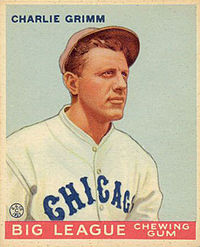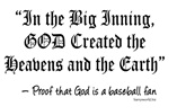
In 1916, a 17 year old OF made his MLB debut with the Athletics on what was the worst baseball team- winning percentage wise- in the 20th century or later era. Philadelphia, led by their manager Connie Mack and fresh off a run of three World Series titles in 4 years (1910, 1911, 1913), decided to start trading and selling off some of their top players. The only impact player left from their World Series Championship run was 1B Stuffy McInnis. The team went 36-117, with a .235 winning percentage- the worst since the 1899 Cleveland Spiders went 20-134 for a .130 wp. With a performance as good as the team he played for, Charlie Grimm went 2-22. He fared a little bit better in his next big league action, which came in 1918 for the St Louis Cardinals. He got into 50 games and hit .220. It wasn't until he joined the Pittsburgh Pirates when Grimm became a solid MLB regular and a lot had to do with manager Bill McKechnie.
Grimm would learn a lot from his time with the Pirates, both as a baseball player and a leader. He hit .345 in 1923, which led the team and after the 1924, he was traded to the Chicago Cubs. Ironically, the Pirates won the World Series the following season and member of the WS Championship team was none other than Grimm's one time Athletics teammate Stuffy McInnis. Coming off a very good 4 year run as a run producer for the Pirates, he continued to produce for the Cubs. While he played for the Cubs, he got to play again briefly for his first manager with the Pirates, George Gibson, who took over the Cubs midway through the 1925 season. He got to play for a couple of the greats after that, with Joe McCarthy managing the team from 1926-1930 and immortal 2B Rogers Hornsby taking over the team in 1930. The 1929 Cubs won the NL Pennant under McCarthy with Hornsby at 2B and Grimm at 1B.
During the 1932 season, the decision was made by the Cubs to let Hornsby go as manager. Grimm was hired as player/ manager, a duel role he would hold until he stopped playing after the 1936 season. The 1932 Cubs won the NL Pennant, losing this time to the Yankees in the World Series. The 1935 team won 100 games and another NL Pennant, this time losing to the Detroit Tigers in the World Series. For the Tigers, it was their first World Series Championship in 5 tries, having lost the World Series a year earlier to the St Louis Cardinals and 2 of their first three at the hands of the Cubs.
In 1938, the Cubs were in a dogfight to win the National League. The Pirates, GIants and Reds were all in the mix and at the time, even the upstart Boston Braves were playing tough. However, 9 games over .500 was not good enough for the Cubs front office and the decision was made to fire Grimm, replacing him with future Hall of Fame catcher Gabby Hartnett. The Cubs won win the NL Pennant again in 1938, losing once again to the Yankees in the World Series.
Hartnett managed the team through 1940, with Jimmie Wilson taking over for the 1941 season. Wilson had previously spent 5 seasons as player/ manager with the Philadelphia Phillies. Wilson stuck around through the beginning of the 1944 season, when he was let go with the Cubs off to a 1-9 start. After pitching coach Roy Johnson managed 1 game with the interim tag, Grimm took over the club once again. He led the team that had started out 1-10 to a 75-79 record, with the club going 5 games over .500 under Grimm's guidance.
The Cubs took off in 1945, led by Phil Cavaretta, Andy Pafko and 22 game winner Hank Wyse. They won the Pennant once again, this time with 98 wins setting up another date with the Tigers in the World Series. Unfortunately, the more recent history repeated itself as the Tigers won in 7 games. With the series tied at 3 and game 7 in Wrigley Field, the Tigers opened their half of the first inning with a 5 spot and never looked back in a 9-3 victory. Sadly, the Cubs have never been back since. Grimm would stay on as manager through the 1949 season and was brought back to start the 1960 season.
When it comes to the discussion of "Mr Cub," there will always only be one with Ernie Banks. I have spoken about the impact of Frank Schulte in the early Cubs teams and his place on the World Series Championship teams in 1907 and 1908. But Charlie Grimm, or Jolly Cholly, as he was called, certainly has his place in the history of the Chicago Cubs franchise. He played 12 seasons for them and managed them another 14 years (5 as player/ manager). During his time with the Cubs, he either played or managed (or both) on four of the last five Cubs NL Pennant clubs. And the one World Series he did not oversee the club, he was let go with the Cubs 9 games over .500. So, technically Charlie Grimm was a part of the last five Cubs teams that got to the World Series. And his 14 years in the Cubs dugout were the most managed by a Cubs manager since the 19th century, when Cap Anson led the Chicago White Stockings and Colts from 1879-1897. His 2299 career hits and .547 winning percentage as a manager for 19 seasons is not a bad resume either. If the Baseball Hall of Fame never calls, at least the Cubs can do a little more to honor "Jolly Cholly" Grimm. Perhaps they can retire the last number he wore while playing for the Cubs (8). Maybe it can be the numbers 6 or 11, which Grimm happened to be the first in the history of the franchise to wear either number. Did he wear number 8 as the team's manager? If anybody can confirm what number he wore when he was the Cubs manager, I will mention your name on the next edition of the Passed Ball Show. Thanks for the help if you can. JP

 RSS Feed
RSS Feed
